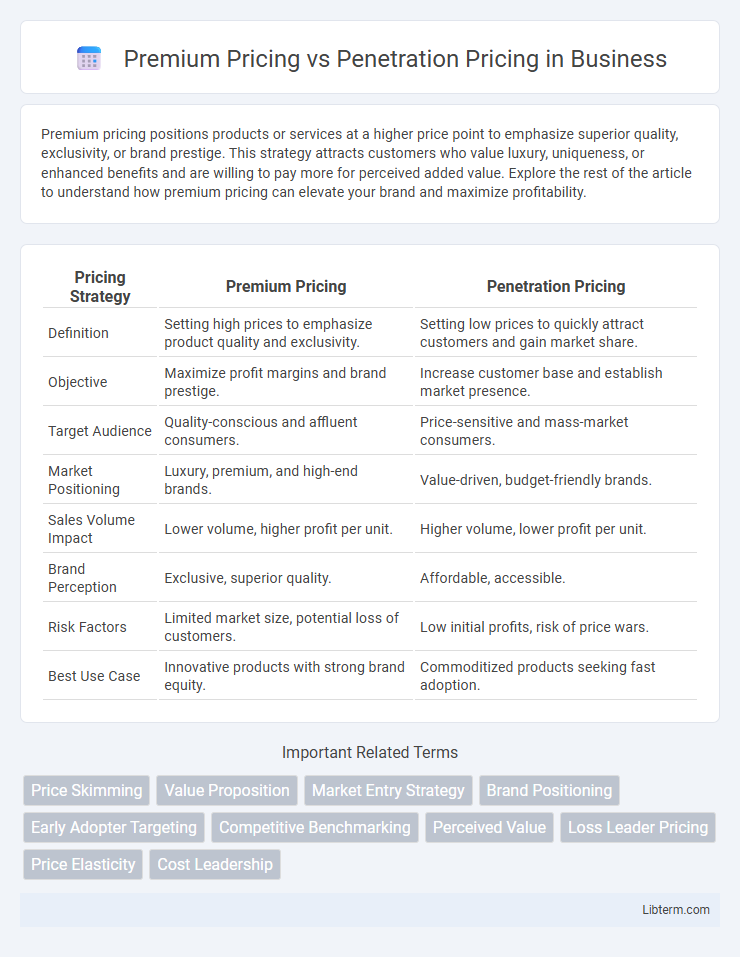Premium pricing positions products or services at a higher price point to emphasize superior quality, exclusivity, or brand prestige. This strategy attracts customers who value luxury, uniqueness, or enhanced benefits and are willing to pay more for perceived added value. Explore the rest of the article to understand how premium pricing can elevate your brand and maximize profitability.
Table of Comparison
| Pricing Strategy | Premium Pricing | Penetration Pricing |
|---|---|---|
| Definition | Setting high prices to emphasize product quality and exclusivity. | Setting low prices to quickly attract customers and gain market share. |
| Objective | Maximize profit margins and brand prestige. | Increase customer base and establish market presence. |
| Target Audience | Quality-conscious and affluent consumers. | Price-sensitive and mass-market consumers. |
| Market Positioning | Luxury, premium, and high-end brands. | Value-driven, budget-friendly brands. |
| Sales Volume Impact | Lower volume, higher profit per unit. | Higher volume, lower profit per unit. |
| Brand Perception | Exclusive, superior quality. | Affordable, accessible. |
| Risk Factors | Limited market size, potential loss of customers. | Low initial profits, risk of price wars. |
| Best Use Case | Innovative products with strong brand equity. | Commoditized products seeking fast adoption. |
Introduction to Premium and Penetration Pricing
Premium pricing involves setting a high price point to create an image of exclusivity and superior quality, targeting customers willing to pay more for perceived value. Penetration pricing sets a low initial price to quickly attract customers and increase market share, often sacrificing short-term profits for long-term growth. Both strategies align with different marketing objectives and customer segments based on product positioning and competitive landscape.
Defining Premium Pricing Strategy
Premium pricing strategy involves setting a higher price point to signal superior quality, exclusivity, or brand prestige, attracting customers willing to pay more for perceived added value. This approach leverages brand differentiation, emphasizing product uniqueness and exceptional features to justify the elevated cost. Companies utilizing premium pricing often target niche markets where consumers associate higher prices with increased status or enhanced performance.
Understanding Penetration Pricing Strategy
Penetration pricing strategy involves setting a low initial price to quickly attract customers and gain market share, especially in competitive industries. This approach helps businesses build brand awareness and encourage trial purchases, which can lead to long-term customer loyalty. Companies using penetration pricing often face short-term profit sacrifices but benefit from increased sales volume and market presence.
Key Differences Between Premium and Penetration Pricing
Premium pricing targets high-income consumers willing to pay more for exclusive or high-quality products, emphasizing brand prestige and product uniqueness. Penetration pricing sets low initial prices to quickly attract a large customer base and gain market share, often sacrificing short-term profits for long-term growth. Key differences lie in pricing strategy goals: premium pricing maximizes profit margins per unit, while penetration pricing prioritizes market entry speed and volume.
Advantages of Premium Pricing
Premium pricing enhances brand perception by positioning products as high-quality and exclusive, attracting affluent customers willing to pay more. This strategy increases profit margins, enabling greater investment in product development and marketing. It also fosters customer loyalty through perceived value and differentiates the brand from lower-cost competitors.
Benefits of Penetration Pricing
Penetration pricing offers the benefit of quickly attracting a large customer base by setting lower initial prices, enabling rapid market share growth and enhanced brand awareness. This strategy promotes customer trial and loyalty through cost savings while discouraging competitors from entering the market due to reduced profit margins. It also helps achieve economies of scale faster by increasing sales volume and lowering per-unit costs.
Factors Influencing Pricing Strategy Choice
Factors influencing the choice between premium pricing and penetration pricing include target market demographics, product differentiation, and competitive landscape. Premium pricing suits products with high perceived value and brand loyalty, while penetration pricing targets rapid market share growth in competitive or price-sensitive markets. Cost structure, marketing objectives, and customer price sensitivity also play critical roles in determining the optimal pricing strategy.
Industry Examples: Premium vs. Penetration Pricing
Apple exemplifies premium pricing by maintaining high prices for its iPhones, emphasizing quality and brand prestige to target affluent consumers. Conversely, Netflix utilized penetration pricing during its early expansion by offering low subscription fees to rapidly gain market share in the streaming industry. The automotive sector shows Tesla adopting premium pricing for its electric vehicles, whereas Tata Motors employed penetration pricing for its affordable Nano model to attract cost-sensitive buyers.
Risks and Challenges of Each Pricing Method
Premium pricing risks include alienating price-sensitive customers and limiting market share due to high price points that may not align with perceived value. Penetration pricing challenges involve potential profit margin erosion and customer expectations for permanently low prices, making future price increases difficult. Both strategies require careful market analysis to balance revenue goals with consumer behavior and competitive dynamics.
Choosing the Right Pricing Strategy for Your Business
Choosing the right pricing strategy, such as Premium Pricing or Penetration Pricing, depends on your business goals, target market, and product positioning. Premium Pricing works best for brands emphasizing quality, exclusivity, and strong brand identity, enabling higher profit margins. Penetration Pricing suits businesses aiming to quickly capture market share by offering lower prices, making it ideal for new entrants seeking rapid customer acquisition.
Premium Pricing Infographic

 libterm.com
libterm.com